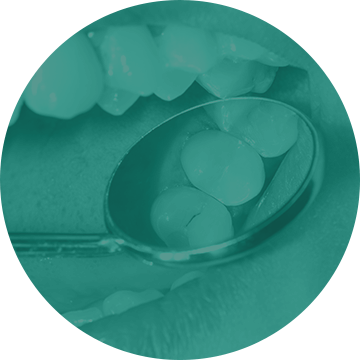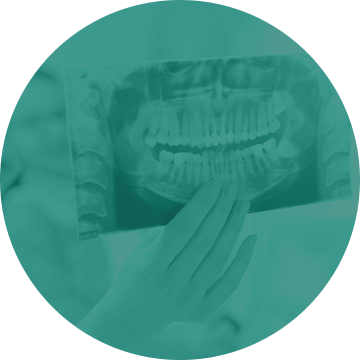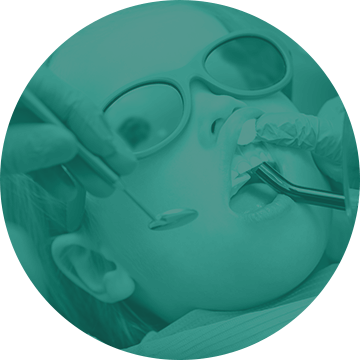Our Services
Exams
When to Schedule
The American Academy of Pediatric Dentistry and the American Dental Association advise scheduling a child’s initial dental exam after the first tooth erupts and no later than their first birthday. Also, expect your baby’s teeth and gums to be examined at well-baby checkups.
What to Expect
When you bring your baby to Ingalls Pediatric Dentistry, our staff will focus on making your little one feel comfortable and at ease. Our colorful décor punctuated with sea creatures is intended to create a fun and enjoyable experience for your baby. We speak to our young patients with show-and-tell techniques so they can understand conceptually what is going on.
Your child’s initial visit will be brief and involve very little treatment. During this time, we will introduce your child to our dentist in a relaxing, calm atmosphere, beginning to introduce dental tools and machinery.
At this appointment, the dentist will check all of your child’s teeth for decay, and examine their bite, while searching for any potential problems with the gums, jaw, and oral tissues. We may also clean whatever teeth are there and determine the need for fluoride. Regular dental visits will get your child comfortable with the process and ensure that any dental health issues are identified in the early stages.
Reach out to Ingalls Pediatric Dentistry
If you would like to learn more about how your baby’s first dental appointment will go, we invite you to contact Ingalls Pediatric Dentistry and schedule an appointment today!

Cleanings
A twice-a-year dental cleaning is a smart precaution to take to reduce the chances of tooth decay or cavities from occurring. For children who practice good oral health with guidance from their parents, the dental cleaning process causes very little or no discomfort.
A professional dental cleaning every six months can improve your oral health, according to the Academy of General Dentistry (AGD), an organization of dentists committed to continuing dental education.
This cleaning gives dentists an opportunity to locate areas in your child’s mouth that might need special attention.
Teeth cleanings, usually performed by a dental hygienist or dental assistant, include a physical exam of the mouth, looking for any signs of gingivitis (inflamed gums) and other potential concerns.
Next is removing plaque and tartar as the dentist or dental hygienist uses a scaler to eliminate the plaque and calculus around the gum line.
Then comes the air-powered brush that is designed to perform a deep and gentle clean. Your child’s teeth are scrubbed and polished.
Expert flossing comes next as your dental hygienist gets between your child’s teeth and identifies potential trouble spots that could include bleeding gums.
The final stage of a dental cleaning is rinsing that is typically followed with a gel fluoride.
Reach out to Ingalls Pediatric Dentistry
If your child needs a dental cleaning, we invite you to contact Ingalls Pediatric Dentistry and schedule an appointment today!

Sealants
Dental Sealants As a Cavity Prevention Measure
While cavities, especially in our childhood years, are not uncommon, they are very preventable. Even good oral care doesn’t guarantee your child won’t develop cavities. But there is a measure you can take to greatly lessen the likelihood of your child developing cavities — dental sealants. In certain circumstances, dental sealants could be appropriate for baby teeth, including when your youngster’s baby teeth have deep depressions, pits and grooves.
How Dental Sealants Work
How do dental sealants stop cavities in their tracks? Dental sealants are designed to prevent cavities from developing by creating a firm, physical barrier between your child’s teeth and the oral bacteria that causes tooth decay. With their protective barrier, dental sealants interrupt this process and prevent cavities. These sealants essentially prevent tooth decay by sealing out plaque and food. They are especially needed during the cavity-prone years of ages 6 to 14.
Dental sealants can be used on both baby (primary) and adult (permanent) teeth. In most situations, they are applied to the rear teeth (molars and premolars) as these teeth have a larger surface area along with more pronounced grooves and pits. These characteristics mean there is a greater chance of trapping bacteria that cause decay.
When correctly applied, dental sealants can last for 10 years. However, they should be checked for chipping or wearing at regularly scheduled dental check-ups, and later repaired to offer the full protection.
What to Expect
The Dental Sealant Process
The process for applying dental sealants is simple, painless, and relatively quick. Just a few minutes after brushing the teeth with the air-powered brush, the dentist will apply the dental sealant. The dental assistant will place absorbent cotton to help keep the teeth dry after preparing them and rinsing them thoroughly. The dental assistant will paint resin onto your child’s teeth. Afterwards, a blue light is used to harden it. The bite must be verified and the tooth polished to maintain the proper occlusion. The dental sealant application for each tooth takes just a few minutes.
Who is a Good Candidate for Dental Sealants?
Any child that is predisposed to cavities is an ideal candidate for dental sealants, as they will prevent tooth decay. The teeth with deeper grooves, pits and depressions will benefit the most and should be monitored and repaired to maximize the benefit. What’s more, dental sealants are often covered by dental insurance for children under the age of 18.
Reach Out to Ingalls Pediatric Dentistry in Lake Mary
If you would like to learn more about dental sealants and discuss what options are best for you, we invite you to contact Ingalls Pediatric Dentistry and schedule your appointment today!

X-Rays
The practice of dentistry and x-ray technology have been intertwined for a century now. Radiographs (x-ray pictures) enable dentists to diagnose and treat problems not yet visible to the naked eye, including early tooth decay, gum disease, abscesses and abnormal growth.
It is quite clear that this diagnostic tool prevented much suffering and saved countless teeth. Now, state-of-the-art digital x-rays have made the technology even safer and more beneficial.
How Digital X-Rays Work
Digital x-ray technology uses a tiny electronic sensor that goes into the mouth to capture an image. This picture can be viewed instantly on a computer screen.
This advanced technology came on the dentistry scene 20 years ago and immediately offered a host of advantages over traditional x-rays films, which require chemical processing.
Digital x-rays also brought with them good health news — a significant reduction in the amount of radiation exposure to dental patients. There is no doubt that digital x-rays offer the lowest radiation dose possible.
Advantages of Digital X-Rays
In addition to dramatically lowering radiation exposure, digital x-rays provide several other distinct advantages to the field of dentistry and dental patients. These include:
No Chemical Processing and No Waiting — Because there is no film to process with digital x-rays, patients can see results instantaneously. There is no waiting for pictures to develop, and no toxic chemicals to discard. Your dentist can show you right away the pictures on a computer screen for convenient viewing.
A Clearer Picture — Because digital x-rays are much sharper and can be enhanced in numerous ways, dentists can get more information from digital x-rays. The contrast can be increased or decreased, and areas of concern can be magnified. They also allow for comparing old and new x-rays, which makes possible the detection of the minutest changes to a tooth structure.
Easy Sharing and Storage — Digital x-rays offer a superior visual aide for you, the patient, to understand your diagnosis and treatment options. They can also be emailed to various locations.
Reach out to Ingalls Pediatric Dentistry
If you would like to learn more about digital x-rays and their benefits to your oral health, we invite you to contact Ingalls Pediatric Dentistry and schedule an appointment today!

Extractions
Although primary teeth usually last until the permanent teeth come in and permanent teeth are intended to last a lifetime, there are several reasons why tooth extraction might be necessary. One of the primary reasons for tooth extraction is that a tooth is too badly damaged from trauma or has decay, and it cannot be repaired.
There are a few other reasons a tooth might have to be removed. They include:
Over-Retained Teeth— Sometimes a baby tooth will not come out at the appropriate time and the permanent tooth may come in on one side of the baby tooth or get stuck in the bone. These baby teeth can have sharp sides which pinch the gums when biting food, or even get infected if food and bacteria get into the live part of the tooth and cannot be cleaned out.
Crowded Mouth — In preparation for orthodontia, teeth may have to be removed, or because a patient’s teeth are tipped to the side and may get stuck in the bond. Occasionally there are even teeth which are extra, supernumerary teeth, or too large, macrodontia.
Infection — This involves tooth decay or damage extending to the tooth pulp, which is the center of the tooth containing nerves and blood vessels. Bacteria in the mouth could get into the pulp, leading to infection.
Risk of Infection — This could be the result of the immune system being compromised, which heightens the risk for infection in a particular tooth.
Periodontal (Gum) Disease — An infection of the tissues and bones that surround and support the teeth, which is periodontal disease, can cause loosening of the teeth. That’s when it may be necessary to pull the tooth or teeth.
Trauma — In the toddler years and into the active adolescent years dental trauma is an unfortunate occurrence which can result in the need to remove a baby tooth to protect the developing permanent teeth and preserve a healthy smile. When a permanent tooth is badly damaged it may require extraction to prevent further damage. The use of mouthguards can significantly reduce the trauma to permanent teeth for active children and youth.
Reach Out to Ingalls Pediatric Dentistry in Lake Mary
If you think your child may need a tooth extraction, we invite you to contact Ingalls Pediatric Dentistry and schedule an appointment today!

Fillings
The most common reason or a filling is to fill a cavity in the tooth. Tooth fillings also become necessary to repair damage or missing tooth structure caused by grinding (bruxism), under mineralized teeth (hypoplasia/hypomineralization), defects, or to replace part of a broken tooth.
When your child needs a filling done, expect it to take about an hour. The dentist will need an x-ray and talk to you about the procedure and then complete the dental work.
There are many ways to have a filling done. The types of tooth fillings are gold, silver amalgam, tooth-colored composite material, porcelain, and a special type of glass ionomer. Cost and aesthetic preference are two factors that persuade people on which tooth fillings to go with.
There is the chance your child may experience some discomfort, which is why the dentist will numb your child’s gums, and surrounding skin to lessen the pain involved. Our dentists at Ingalls Pediatric Dentistry make it their priority to ensure your child is as comfortable as possible during this process!
Tooth fillings typically last for many years before needing to be replaced.
Reach out to Ingalls Pediatric Dentistry
If you would like to learn more about fillings or just want your child to come in for an examination, we invite you to contact Ingalls Pediatric Dentistry and schedule an appointment today!

Fluoride Treatments
Fluoride is a natural mineral that helps to create strong teeth and it assists in preventing cavities. Fluoride has been an important oral health treatment for many years.
During a fluoride treatment, the fluoride will be in the form of a highly concentrated rinse, foam, gel, or varnish. The dentist will apply the fluoride with a swab, brush, tray, or mouthwash.
The reason for these fluoride treatments is that they give your child the topical advantage of much more fluoride than what is found in water or toothpaste. Typically, these fluoride treatments take just several minutes to apply.
We will advise you to have your child postpone eating, drinking or rinsing for at least a half hour after the fluoride treatment so the fluoride can be completely absorbed.
Fluoride treatments will be recommended for your child every three, six, or 12 months, depending on your child’s oral health situation. Your dentist may also suggest additional preventive measures if your child is at moderate or high risk of developing caries, which are tooth decay or cavities.

Growth and Development
Monitoring your child’s growth and development is a vital and relevant aspect to their dental care. At Ingalls Pediatric Dentistry, we place an emphasis on the development of your child’s dentition through early intervention and possible referral to the orthodontist.
Why does your child need regular monitoring of the health and growth of their teeth? Because it is easier to prevent cavities and other oral health problems than it is to resolve the issues after they have started.
Our dentist will closely monitor the growth of your child’s face, teeth, and jaws to identify any abnormalities before they are a major problem. With regular dental checkups, our dentist can possibly improve dental function and appearance prior to orthodontic work and even surgical concerns arise.
Another facet of monitoring development in your child is watching how their baby teeth evolve. For example, what if baby teeth are lost early, or teeth drift and severe crowding may result. Making sure teeth erupt properly will bring about a stable bite.
We recommend you bring your child in for an initial dental exam as soon as their teeth begin to erupt.
Reach out to Ingalls Pediatric Dentistry
If it’s time to bring your child in for a routine dental exam, we invite you to contact Ingalls Pediatric Dentistry and schedule an appointment today!

Space Maintainers
How They Work
Looking after your child’s primary teeth and making sure they are healthy is a major priority at Ingalls Pediatric Dentistry. These primary teeth are critical when it comes to helping your youngster bite and chew. They also help to guide the permanent teeth underneath them into their precise, correct position. Baby teeth have the important responsibility of establishing space for the permanent teeth that will eventually replace them.
At Ingalls Pediatric Dentistry, we offer space maintainers, a restorative option to preserve the space where your child’s missing tooth used be. Space Maintainers, also known as a space maintenance appliance, will prevent permanent teeth from coming in the wrong place or coming in crooked. Ultimately, space maintainers will ensure your child’s smile and teeth are healthy as their permanent teeth grow in where they are supposed to.
When to Consider Space Maintainers
Space Maintainers are necessary when a child is missing a tooth. A space maintainer will help prevent the need for corrective orthodontia later. However, space maintainers may not be necessary if a youngster loses a primary tooth prematurely if the permanent tooth is starting to grow in.
Space maintainers could also be helpful in situations where one or more permanent teeth are congenitally missing (do not develop). In this circumstance, permanent dental implant teeth are typically needed to replace the missing teeth after growth has completed. A space maintainer with a false tooth in it can be used until jaw growth is complete and an implant can be correctly placed.
Reach out to Ingalls Pediatric Dentistry
If you would like to learn more about Space Maintainers and discuss what options are best for you, we invite you to contact Ingalls Pediatric Dentistry and schedule your appointment today!

